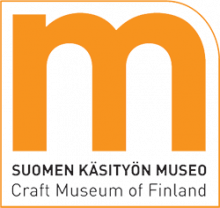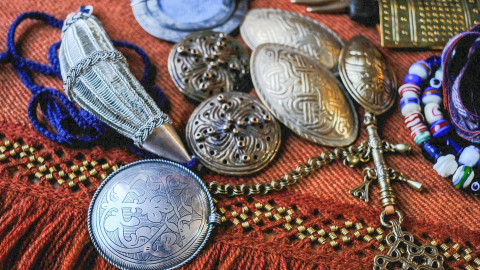From an Archaeological Find to an Ancient Costume 22.4.–18.9.2022
In ancient times, a mighty matron was buried covered in her cloak of shimmering bronze spiral ornaments, with a magnificent tablet-woven belt around her waist. Almost a thousand years later, as a result of the collaboration of archaeologists' research and craftsmen's skills, ancient costumes tell the story of the magnificent clothing and skilful craftsmanship of the Iron Age. The exhibition From an Archaeological Find to an Ancient Costume at the National Costume Center of Finland illustrates the research methods used to study ancient costumes and the handicraft techniques used to make the reconstructions, such as the stunning tablet-woven bands.
Visitors can see with their own eyes what an ancient matron might have looked like in her lifetime. A costume including a bronze spiral decorated cloak, took master crafter Mervi Pasanen around 300 hours to make.
The exhibition is created by archaeologist, MA Jenni Sahramaa, master crafter Mervi Pasanen, archaeologist, PhD Krista Wright and textile conservator Maikki Karisto. The exhibition has been made in cooperation with the project "From an Archaeological Find to an Ancient Costume" and the Kalevala Women's Association's project "Maalöydöstä koruksi" as part of the popularisation of archaeological textile research. The exhibition is on display at the Kuja in the Craft Museum of Finland 22.4.–18.9.2022.
In Iron Age Finland, cremation burial of the dead was in use for a long time. By the end of the Early Iron Age and the beginning of the Middle Ages from 11th to 13th century, was a period of transition in Finland, when the dead were given inhumation burial, but still dressed in the old way and with grave goods. This method offers archaeologists a unique opportunity to gain information about the costumes of the past, as small amounts of textiles and fur have also been preserved in graves, especially near metal objects. By carefully studying these remains, their location in the grave and their relationship to each other, it has been possible to produce reconstructions, ancient costumes. However, the amount of preserved textiles in graves is so small that their interpretation is challenging. The costume reconstructions are therefore always an interpretation and reflect the of their period of making.
Archaeological textiles can be studied using several different methods. The study of textiles found in a grave starts by documenting the different types of textiles and their characteristics. If similar textiles are found in more than one part of the grave, it can be assumed that they belong to the same piece of clothing. Jewellery, decorations and finishing practices compared to previously examined finds will help to determine which these garments may be.
The deceased is dressed for the grave and provided with offerings, mainly by those close to him or her. The furnishing that the deceased has received can tell us about him or herself, but also about the customs and beliefs of the community and the perceptions, hopes and fears of those who perform the burial. The symbolic meanings associated with the burial are difficult for later scholars and observers to grasp. The deceased's jewellery and grave goods are often seen as a reflection of his wealth, but the image that survives can also be very distorted. If the deceased did not have a lot of metal jewellery on his or her costume, other materials have not survived. Burials that appear empty today may well have once contained a wealth of objects made of wood, bone, cloth, furs, feathers, leather and other organic materials that have disappeared without trace over the centuries.
Archaeological textiles cannot be touched as they are usually very fragile. This is because the once soft and organic fibres have become hard and brittle as glass over the centuries. Detailed research methods often rely on microscopy or other imaging, chemical analysis, and the examination of small samples. Visual examination is used to investigate the structure of fabrics, the threads and spinning characteristics of yarns, and the details of seams and decorations. At this stage, small samples of textiles are often taken for further research.
Experimental archaeology is used to investigate the techniques used to make ancient textiles. Making of costume reconstructions has also provided information on how labour-intensive and time-consuming it was to make textiles using ancient methods. In addition, the natural dyes used to dye textiles can be determined chromatographically, textiles can be dated by radiocarbon dating, and amino acid analysis can be carried out on very degraded fibre material. Sheep wool can also be used to determine the geological region in which the sheep that produced it lived. All this provides more information about traditional costume culture, and where textiles were made and traded.
From an Archaeological Find to an Ancient Costume
Exhibition at Kuja in the Craft Museum of Finland 22.4.–18.9.2022
More information
Marja Liisa Väisänen, curator, the National Costume Center of Finland, [email protected], tel. +358 50 311 8247

